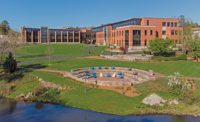Bowdoin College, John and Lile Gibbons Center for Arctic Studies and Barry Mills Hall
Brunswick, Maine
BEST PROJECT
Submitted by: Consigli Construction Co.
Owner: Bowdoin College
Lead Design Firm | Structural & MEP Engineer: HGA Architecture and Engineers
General Contractor: Consigli Construction Co.
Civil Engineer: Sebago Technics Inc.
Landscape Architect: Stimson Studio
Subcontractors: South County Post & Beam Inc. ES Boulos Co.;Johnson & Jordan Inc.; Dean & Allyn Inc.; Maine Masonry Company Inc.; Ace Corp.; Windham Millwork Inc.
The 100% mass timber buildings built in the heart of Bowdoin College's campus were the first commercial-scale mass timber buildings to rise in the state. The school used Austrian Spruce glue laminated beams, columns and trusses and other materials to build the two structures for its Center for Arctic Studies, which focuses on the Arctic as well as the Inuit community’s history and climate education about rising sea level and Arctic Ocean warming.
Aside from teaching and lab space, the center also houses a museum, a two-story academic building with classroom space, collaborative research space and a 300-person event space. While the two buildings appear to be separate, they are joined below ground by a corridor and utility/pedestrian tunnel. Bowdoin, which achieved carbon neutrality two years ahead of schedule in 2018, selected all-electric MEP systems such as electric boilers and heat recovery units.

Photo by Robert Umenhofer Photography, courtesy Consigli Construction Co.
The $28.5-million, 46,000-sq-ft project finished at budget and on schedule in 21 months To achieve cost savings, Consigli completed a 4D model with cost analysis comparing mass timber to a more traditional steel, concrete and masonry superstructure to show how mass timber prefabrication was the optimal choice.
The cost comparison was funded with support from the U.S. Forest Service. The college is one of 10 institutions to receive funding from the agency, which is joined by the nonprofit U.S. Endowment for Forestry and Communities to bring sustainable change to the nation’s working forests and forest-reliant communities.
Securing commodity material lead times amid extreme volatility and securing a skilled workforce were major challenges. By developing construction documents during early design, the team was able to secure pricing for the mass timber ahead of significant lumber price increases.
To secure builders risk insurance for the project, the team employed risk management tools including digital/wireless security as well as water, fire and smoke monitoring. It also implemented a sitewide video monitoring and motion sensing system that monitors free-standing water, fire and smoke to detect any hazards to timber and immediately notify the owner of site activity.




